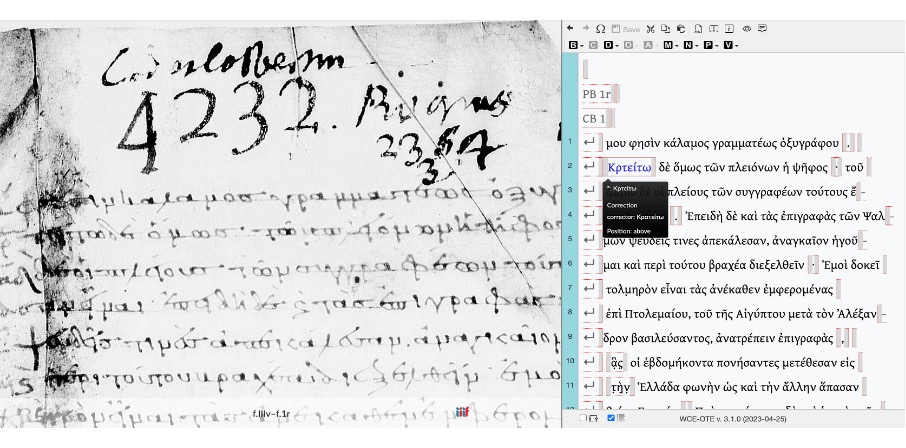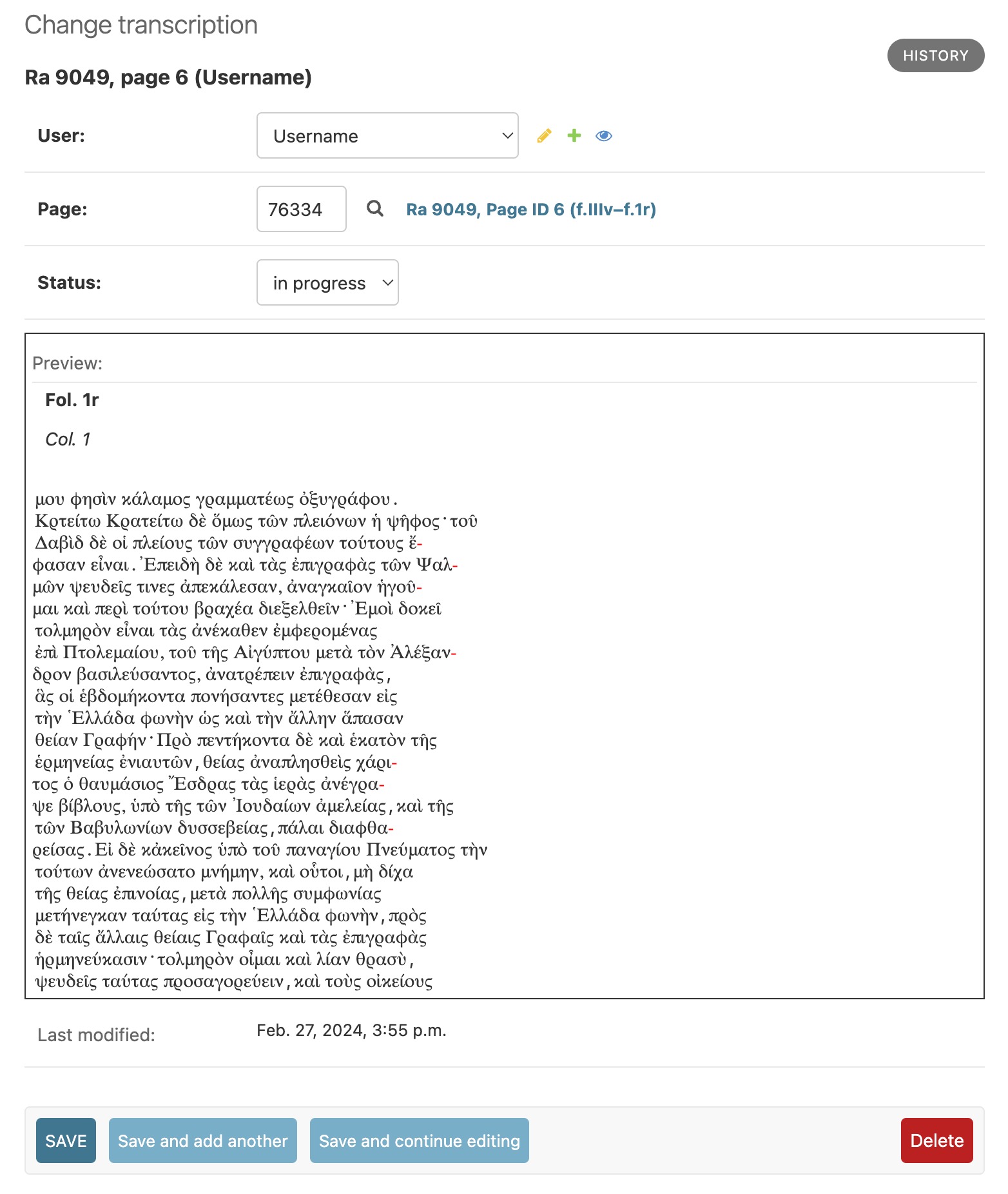
An Editing Environment for Theodoret’s Interpretatio in Psalmos
Malte Rosenau
February 29, 2024
In recent times, the landscape of digital tools for creating critical editions has significantly expanded, offering scholars a wide array of options.[1] Yet, for many edition projects, the choice is often between the Classical Text Editor or an TEI-XML-based workflow in Oxygen, sometimes alleviated through plugins like Ediarum which are built on top of Oxygen’s XML Author mode. While the Classical Text Editor is an excellent tool for scholarly editions in book format, the requirements for clean TEI-XML output for web publishing from CTE can be quite challenging,[2] which has led some projects to abandon it altogether. Additionally, both solutions are uniquely offline and require a financial commitment due to their commercial licensing. The integration of collaborative features, which are prevalent in contemporary web applications, is notably absent.[3]
With the critical edition of Theodoret’s Interpretatio in Psalmos as the main objective of the current project phase, it became clear that the Editio Critica Maior of the Greek Psalter was in need of a web-based editing solution that integrates well into its existing web application, Göttinger Septuagina. An TEI-XML based workflow was also an important requirement due to the fact that the edition of Theodoret’s commentary will eventually be published in the Patristic Text Archive through our cooperation with the BBAW project Die alexandrinische und antiochenische Bibelexegese in der Spätantike. While not strictly a prerequisite, the ability to publish diplomatic editions for all relevant manuscripts online would also be welcome feature.
After an evaluation phase, the Göttingen Psalter project finally decided to use the Online Transcription Editor (OTE), an editing component based on TinyMCE, originally developed at the University of Trier. The OTE is currently in production use and actively maintained by two other Academy projects, namely the Editio Critica Maior of the Greek New Testament (Münster) and the Digital Edition of the Coptic Old Testament (Göttingen), but support also comes from the Institute for Textual Scholarship and Electronic Editing at the University of Birmingham. As an editing component for scholarly editions, the OTE provides a user-friendly web-based environment in which manuscripts can be transcribed with EpiDoc conformant TEI-XML markup. The WYSIWYM (what you see is what you mean) approach of the OTE has the unique advantage, that it hides a lot of the complexity that usually comes with structural markup languages like TEI-XML, without compromising on the markup necessary for a diplomatic edition of an ancient manuscript. The editor provides support for basically all relevant manuscript phenomena like corrections, lacunae, marginalia, abbreviations, rubrications, etc. and handles their representation in TEI markup internally, which gives the user a relatively distraction-free working environment.

As a JavaScript library, the OTE could easily be integrated in the project’s existing research environment for manuscripts built on OpenSeadragon. The image above shows a sample transcription of Ra 9049 (Paris, BnF, Grec 1051) within the OTE and next to the image viewer component. The theme of the editor was slightly modified to match the general appearance of our website. All manuscripts must be transcribed on a per page basis.[4] The transcriptions of an individual user are currently stored as TEI-XML fragments into the database.[5] To spare the user the burden of having to type in the text from the scratch, the editor also has a built-in function to load a section of Theodoret’s commentary. The user then only needs to adjust this so-called “basetext” to the actual text of the manuscript. For pages that have been indexed in advance, this text can be inserted automatically. Alternatively, users have the option to define a specific text range, either by referencing a biblical verse or by utilizing the original page numbers found in J.P. Migne’s Patrologia Graeca, which itself is derived from Schulze’s edition.
Since the OTE was originally designed for mass transcriptions of Greek New Testament manuscripts, the edition of a biblical commentary is indeed a new use case for the editor, that brings its own challenges. One problem, for instance, was the integration of the non-biblical commentary material into the hierarchical structure (i.e. book > chapter > verse) used for biblical texts encoded in TEI-XML. For the sake of simplicity, we decided to keep the commentary text out of the structure for biblical verses in the OTE and treat these passages like sibling elements (see screenshots below).

Since the Transcription Editor did not include any rendering functionality for XML beyond the editor’s own user interface, it became also necessary to create an HTML preview for the transcriptions. The easiest way to achieve this, was the integration of CETEIcean.js, a CSS and JavaScript library to create a highly customizable visualization of TEI/XML in HTML without the need for XSL transformations. The HTML preview was also added to the project’s database backend. The screenshot below shows an example for an TEI-XML transcription rendered into HTML within the website’s admin interface.

[1] A useful overview on resources for digital editing can be found on the website of the KONDE Weißbuch Digitale Editionen, see Klug, Helmut W., Selina Galka, and Elisabeth Steiner, eds. 2021. “Tools.” In: Weißbuch Digitale Editionen. Graz: HRSM-Projekt Kompetenznetzwerk Digitale Editionen (Link).
[2] Cf. Tara L. Andrews, Where are the Tools? The Landscape of Semi-Automated Text Edition, in: Helmut W. Klug and Roman Bleier, Digitale Edition in Österreich, Schriften des Instituts für Dokumentologie und Editorik 16, Norderstedt 2023, 5–6 (Link).
[3] An often overlooked software suite in this respect is the Virtual Manuscript Room. Collaborative Research Environment (VMR-CRE). The VMR integrates various components for digital editing into a web application that offers as collaborative working experience for larger teams on an edition project.
[4] The per-page approach is merely a convenience and not caused by technical constraints. The Online Transcription Editor is capable of handling complete manuscripts.
[5] The project will soon move to a model where all user transcriptions are stored and versioned in a repository within the filesystem.
by Bradley Marsh, June 30, 2025
by Felix Albrecht, May 31, 2025
by Kyle Young, April 30, 2025
by Ippolita Giannotta, March 31, 2025
by Jonathan Groß, February 28, 2025
by Malte Rosenau, January 31, 2025
by Ippolita Giannotta, December 16, 2024